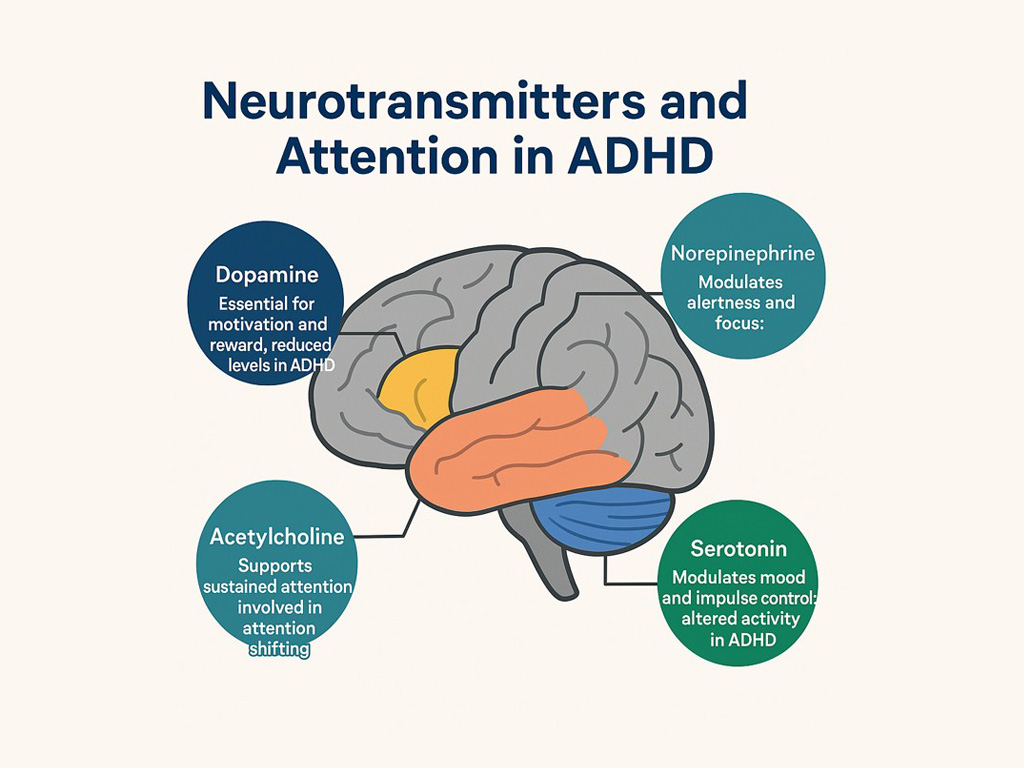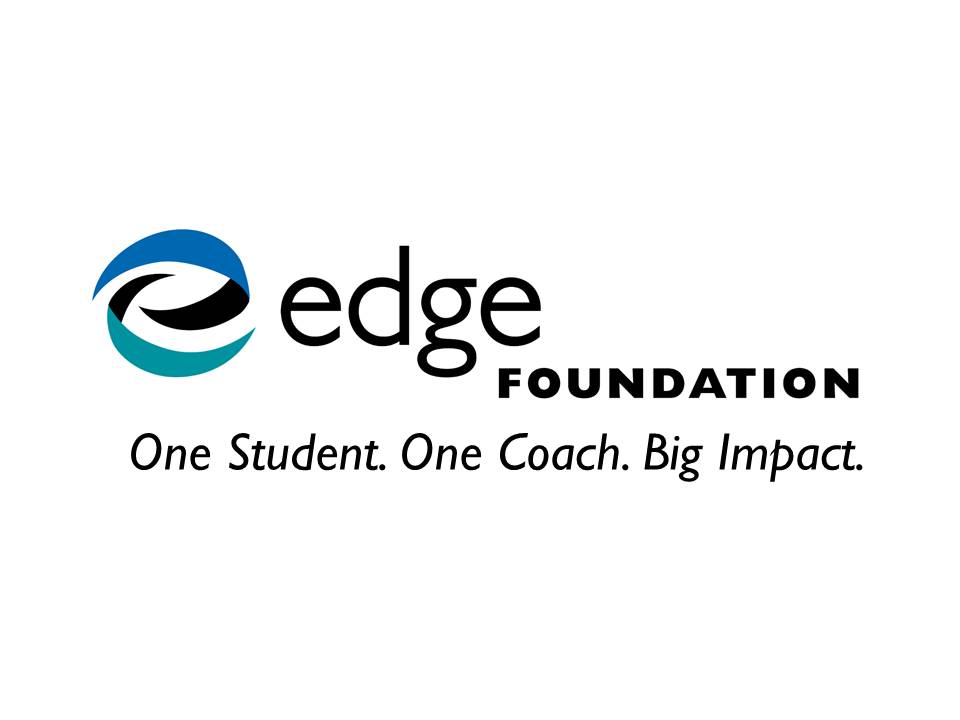
If you have ADHD, you’ve likely felt the tug-of-war between wanting to focus and not being able to. It isn’t a matter of willpower. It’s neurochemistry. Attention is shaped by a dance between key neurotransmitters like dopamine and norepinephrine, with serotonin and others playing supporting roles. Understanding how these brain chemicals interact gives you insight into why ADHD feels the way it does—and points toward strategies that go beyond medication to help regulate attention in everyday life.
The Big Three: Dopamine, Norepinephrine, and Serotonin
1. Dopamine: The Motivation and Reward Messenger
Dopamine drives your ability to stay engaged, anticipate rewards, and follow through on tasks. People with ADHD often have lower dopamine activity in the prefrontal cortex and striatum, the brain regions responsible for focus, goal-setting, and effort regulation. When dopamine is low, tasks that aren’t immediately stimulating feel impossible to start or finish.
2. Norepinephrine: The Focus and Alertness Filter
Norepinephrine helps regulate arousal, alertness, and the brain’s ability to filter distractions. It works alongside dopamine to activate the prefrontal cortex. In ADHD, norepinephrine levels may also be dysregulated, leading to an inconsistent ability to focus and heightened sensitivity to distractions.
3. Serotonin: The Mood and Impulse Regulator
Though less directly tied to attention, serotonin supports emotional regulation and impulse control. Imbalances can lead to irritability, mood swings, and difficulty controlling impulses—common challenges for people with ADHD.
How These Chemicals Work Together
The prefrontal cortex relies on balanced levels of dopamine and norepinephrine to support executive functions like task initiation, working memory, and inhibition. When these levels are too low, the brain struggles to “lock in” to a task. Too much, and the brain becomes overstimulated. This balance is described by an “inverted U” curve—moderate levels lead to optimal focus.
Serotonin plays more of a background role, shaping the emotional environment in which attention operates. Poor serotonin regulation can lead to mood-driven distractibility or impulsive reactions that derail focus.
In ADHD, the combined dysregulation of dopamine and norepinephrine makes it hard to activate and sustain attention, especially for tasks that are boring, effortful, or delayed in reward. This isn’t about laziness—it’s a chemical imbalance. Understanding this helps reduce stigma and opens the door to effective, individualized strategies.
Beyond Medication: Complementary Strategies to Regulate Attention
While medications like stimulants can help rebalance dopamine and norepinephrine, they aren’t the only tools available. Many people with ADHD benefit from a combination of lifestyle strategies that support brain chemistry and executive function.
1. Structure and Routine
-
Why it works: Predictable routines reduce the cognitive load on executive functions and help the brain conserve dopamine for task engagement.
-
How to use it: Create consistent wake/sleep times, anchor tasks to routines (e.g., “after breakfast, I do 10 minutes of writing”), and use visual schedules.
2. Body-Based Tools: Movement and Exercise
-
Why it works: Aerobic activity boosts dopamine, norepinephrine, and serotonin—often within minutes.
-
How to use it:
-
Use “movement snacks” (short bursts of jumping, walking, or stretching) to reset focus.
-
Regular exercise (even 20 minutes a day) improves sustained attention and mood regulation.
-
3. Mindfulness and Breathwork
-
Why it works: Mindfulness increases dopamine availability and strengthens prefrontal cortex activity, enhancing self-awareness and attention control.
-
How to use it: Try 3–5 minutes of guided mindfulness or deep breathing before starting a task. Apps like Headspace, Smiling Mind, or Insight Timer offer ADHD-friendly meditations.
4. Environmental Design and Sensory Modulation
-
Why it works: ADHD brains are highly sensitive to distractions—minimizing sensory clutter reduces cognitive overwhelm.
-
How to use it:
-
Use noise-canceling headphones or brown noise to block distractions.
-
Organize spaces into task-specific zones with minimal visual clutter.
-
Use task lighting and minimize multitasking.
-
5. Timed Work Blocks and Externalized Focus (e.g., Pomodoro Technique)
-
Why it works: Breaking tasks into short, timed chunks helps bypass underactive reward circuits and creates urgency.
-
How to use it: Try 25-minute sprints with 5-minute breaks. Use timers, visible checklists, or even body doubling (working near someone else) to stay engaged.
6. Nutrition and Sleep Hygiene
-
Why it works: Nutrient-rich diets and sleep directly affect neurotransmitter synthesis and brain function.
-
How to use it:
-
Eat protein-rich meals (supports dopamine and norepinephrine production).
-
Limit sugar spikes that cause energy crashes.
-
Prioritize 7–9 hours of sleep, and avoid screens before bed to preserve melatonin cycles.
-
7. Coaching and Cognitive Behavioral Therapy (CBT)
-
Why it works: Coaching helps build executive function scaffolding and develops self-directed strategies; CBT helps reframe cognitive distortions that drain attention.
-
How to use it: ADHD coaches work collaboratively to build practical tools for time management, self-monitoring, and motivation. CBT can address negative self-talk and improve emotional regulation.
8. Gamification and Self-Reinforcement
-
Why it works: ADHD brains thrive on novelty and rewards—adding game-like elements boosts engagement and dopamine.
-
How to use it:
-
Use habit apps (like Habitica or Forest) that give points for completing tasks.
-
Create personal reward systems: “When I finish this report, I’ll watch an episode of my favorite show.”
-
Attention is a complex brain process shaped by your neurochemistry and your environment. If you have ADHD, knowing how dopamine, norepinephrine, and serotonin interact can help you choose strategies that support—not fight—how your brain works. Medications can help, but daily structure, movement, mindfulness, and intentional design of your routines and spaces are powerful, neuroscience-backed tools that give you more control over your focus and your life.
References
- https://pmc.ncbi.nlm.nih.gov/articles/PMC2626918/
- https://www.aacap.org/AACAP/Families_and_Youth/Facts_for_Families/FFF-Guide/ADHD_and_the_Brain.asp
- https://psychcentral.com/adhd/neurotransmitters-involved-in-adhd—
- https://www.additudemag.com/adhd-neuroscience-101/?srsltid=AfmBOoqsZ_82XYMIH7mP3Gbh1FUqdFhMl-41gOKDYKULcqML1DijqrDz
- https://edgefoundation.org/the-neurochemical-dance-how-neurotransmitters-shape-attention-and-focus-in-adhd/



Leave a Reply